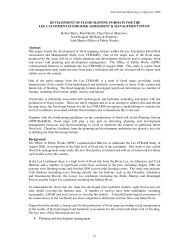Ireland - Mulvany Manning Dublin Principles.pdf - The Office of ...
Ireland - Mulvany Manning Dublin Principles.pdf - The Office of ...
Ireland - Mulvany Manning Dublin Principles.pdf - The Office of ...
You also want an ePaper? Increase the reach of your titles
YUMPU automatically turns print PDFs into web optimized ePapers that Google loves.
Slide Heading<br />
Text 1<br />
Text 2<br />
» Text 3<br />
Title<br />
Subtitle<br />
Hydrology DD th Month in <strong>Ireland</strong> 2005<br />
from <strong>Mulvany</strong>/<strong>Manning</strong> to <strong>Dublin</strong> <strong>Principles</strong><br />
Tommy Bree, IHP/ESBI
Hydrology in <strong>Ireland</strong><br />
Pressures<br />
Pathways<br />
Receptors<br />
Atlantic<br />
Depressions<br />
Complex<br />
Geology<br />
Topography<br />
Slow Run<strong>of</strong>f<br />
in Wetlands,<br />
Peatlands<br />
Fast Run<strong>of</strong>f<br />
in Coastal<br />
Urban Areas
Risk Maps<br />
Many areas where<br />
discharge to<br />
groundwater<br />
cannot occur<br />
throughout a<br />
significant<br />
proportion <strong>of</strong> the<br />
year<br />
Sensitive to<br />
extreme floods and<br />
low flows.
Spatial Planning
Representative Basins<br />
Diverse configurations leads to difficulties<br />
in estimation for ungauged basins<br />
High density gauging networks<br />
Pooling groups for low flows and for floods<br />
Websites “point and click”, outputting<br />
basin maps and descriptors.
Era <strong>of</strong> Empirical Hydrology<br />
Thomas John <strong>Mulvany</strong> studied drainage basins<br />
with recording raingauges and continuous<br />
records <strong>of</strong> water level upstream <strong>of</strong> a control<br />
weir<br />
Time <strong>of</strong> concentration and "rational method"<br />
(Q=CIA) emerged 1845-1852<br />
Land drainage was a famine relief measure<br />
Schemes increased from five or six to the order<br />
<strong>of</strong> 100<br />
Brothers William and Thomas <strong>Mulvany</strong> later left<br />
<strong>Ireland</strong> and set up the Hibernian Mining<br />
Company in Germany. <strong>Mulvany</strong>-straase in<br />
Dusseldorf is named after William.
Thomas <strong>Mulvany</strong>’s Publications<br />
‘On the drainage <strong>of</strong> the Mantua Turloughs in the<br />
County <strong>of</strong> Roscommon, and the formation for that<br />
purpose <strong>of</strong> a deep cut through Kinclare Bog’ 1849<br />
‘On the use <strong>of</strong> screw pumps for unwatering works’<br />
1851<br />
‘On the use <strong>of</strong> self-registering rain and flood<br />
gauges in making observations <strong>of</strong> the relations <strong>of</strong><br />
rainfall and <strong>of</strong> flood discharges in a catchment’<br />
1851
Robert <strong>Manning</strong><br />
Born in Normandy, France in<br />
1816, came to <strong>Ireland</strong> and<br />
practiced as an estate<br />
accountant and lawyer<br />
Joined Board <strong>of</strong> Works and<br />
asked a colleague for “a book<br />
on hydraulics which was not<br />
too difficult for a beginner”<br />
Promoted to Chief Engineer in<br />
1874. At the age <strong>of</strong> 75, he<br />
retired in December 1891.<br />
Served as president <strong>of</strong> the<br />
Institution <strong>of</strong> Civil Engineers <strong>of</strong><br />
<strong>Ireland</strong> in 1877-1878.
<strong>Manning</strong>’s n<br />
U = C R 2 / 3 S 1/ 2<br />
Formula presented in 1889 to Institution <strong>of</strong> Civil<br />
Engineers <strong>of</strong> <strong>Ireland</strong><br />
Based on experiments <strong>of</strong> Darcy and Bazin at Dijon<br />
(1860-1865), on seven international formulas and<br />
on extensive local observations<br />
Similar procedure to IHP! eg FRIEND<br />
<strong>Manning</strong>’s n used in all s<strong>of</strong>tware systems today.
<strong>Manning</strong>’s Definition <strong>of</strong> Problem<br />
“Although the science <strong>of</strong> hydraulics is now nearly<br />
250 years old, it is less than half that time since<br />
anyone could calculate even approximately the<br />
velocity or surface inclination <strong>of</strong> water flowing in<br />
an open channel <strong>of</strong> given dimensions.”<br />
“Anyone who has carefully studied the subject<br />
must have come to the conclusion that it is almost<br />
hopeless to obtain a strictly mathematical solution<br />
<strong>of</strong> the problem, and that even to observe and<br />
record correctly the physical data required is a<br />
matter <strong>of</strong> extreme difficulty, not to say<br />
impossibility”. (1891, p 161-162)
From 1700s to 1900s<br />
Navigation early 1700s<br />
Catchment drainage 1800s,<br />
culminating in the 1945 Arterial<br />
Drainage Act which specified<br />
that drainage must be a on<br />
basin-wide basis<br />
Reservoirs for hydropower and<br />
water supply and flood control,<br />
1900s<br />
Systems Hydrology and IHP<br />
JCI Dooge and JE Nash
Integrated Water Resource<br />
Management<br />
Cornerstone <strong>of</strong> IHP<br />
IWRM based on the four <strong>Dublin</strong> <strong>Principles</strong><br />
presented at the World Summit in Rio de Janeiro<br />
in 1992<br />
<strong>Dublin</strong> Declaration sets out recommendations for<br />
action at local, national and international levels to<br />
reduce the water scarcity, through four guiding<br />
principles.<br />
EU Water Framework Directive<br />
EU Floods Directive
<strong>Dublin</strong> <strong>Principles</strong><br />
Fresh water is a finite and vulnerable resource,<br />
essential to sustain life, development and the<br />
environment<br />
Water development and management should be<br />
based on a participatory approach, involving<br />
users, planners and policy-makers at all levels<br />
Women play a central part in the provision,<br />
management and safeguarding <strong>of</strong> water<br />
Water has an economic value in all its<br />
competing uses and should be recognized as an<br />
economic good.
Boyne Basin Site Visit<br />
UNESCO Heritage Site<br />
Navigation, Drainage<br />
<strong>Manning</strong>’s Drainage<br />
District

















